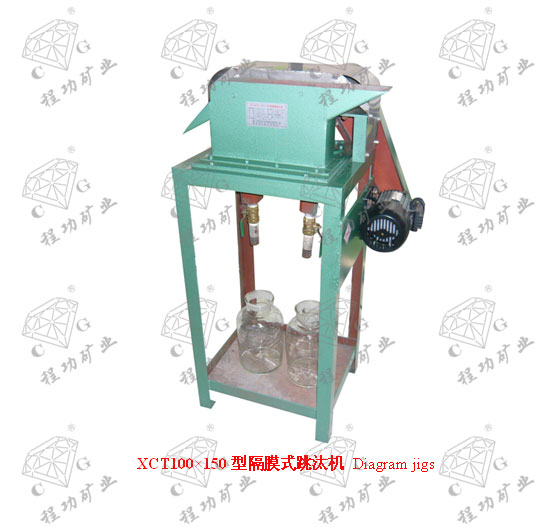
一、用途
Ⅰ.Use
XCT型隔膜式跳汰機用于重力選礦,重力選礦是基于礦石的比重不同,在介質中沉降速度亦異,利用礦物重量上的差別,而完成礦粒混合物的分層選別工作。本產品由原地礦部唯一指定企業生產,執行行業標準。
隔膜式跳汰機適于選別黑色和有色金屬、化學、建筑等方面的實驗研究之用。
XCT Diaphragm Jig is applied to gravity concentration, which makes layered separations of ore grain mixture using difference in mineral weight based on variation of settling speed for the different specific gravity of ores in medium. The product is made by the only manufacturer designated by the former Ministry of Geology and Mineral Resources, in compliance with the Industrial standards.
XCT Diaphragm Jig is suitable to used for research in labs of ferrous and non-ferrous metals, chemical, building materials and other industries.
二、技術參數
Ⅱ. Technical Parameters
| 型號規格 Model | 單位 Uite | XCT100×150 | XCT200×300 |
| 跳汰室長度 Length | mm | 150 | 300 |
| 跳汰室寬度 Width | mm | 100 | 200 |
| 跳汰室數 Jig chamber | (個) | 2 | 2 |
| 跳汰室面積 Area | m2 | 0.03 | 0.06 |
| 偏心****沖程 Stroke | mm | ≤20 | ≤32 |
| 給礦粒度 Feed size | mm | ≤3 | ≤6 |
| 每分鐘沖次 Times of stroke | 1/min | 420 | 346 |
| 處理能力 Capacity | kg/h | 20-70 | ≤700 |
| 篩下水的****量 Water comsumption | L/S | 0.117 | 0.117 |
| 篩上水的****量Water comsumption | L/S | 0.10 | 0.10 |
| 電機功率 Power | kw | 0.4 | 0.75 |
| 外形尺寸Overall dimensions | mm | 752×520×1312 | 1110×520×1312 |
| 重量 Weight | kg | 150 | 175 |
三、結構原理
III. Structure and Working Principle
隔膜式跳汰機,如圖一所示,它上部為長方形,而下部為角錐形的洗礦槽1與2,兩個相連,裝在機架3上構成一體,各槽各有跳汰區A、B和隔膜區C,在A、B兩區之間用不到底的隔板分開。各槽共助于同一傳動裝置4,配水活瓣5,如圖二所示,及補助水管6,跳汰區上部跳汰過程靠隔膜往復運動造成水的鼓動來進行礦物分選,隔膜下沖時,在篩板下面供給補助水,補助水用配水活瓣5來調節,活瓣5與隔膜7的動作是同步的,當隔膜下降時活瓣關閉,水不進入跳汰機中,但隔膜上升時,活瓣啟開因此,減少了跳汰機內下降水流的作用。
As is shown in Figure 1, the top of the diaphragm jig is rectangular and the bottom of it is pyramid-shaped washing trough 1 and washing trough 2. These washing troughs are linked together and installed on frame 3 to become one. There are jigging area A, jigging area B, and diaphragm area C in each trough. Jigging area A and jigging area B are separated by a division plate that does not reach the bottom. Each trough serves the same one transmission device 4 and is equipped with water valve 5 as shown in Figure 2 as well as water pipe 6. The jigging process in the upper side of the jigging area causes the agitation of water through the reciprocating motion of the diaphragm, so as to realize mineral separation. When the diaphragm moves downward, it supply supplement water under the sieve plate. The supplement water is adjusted through the water valve 5. The water valve 5 and diaphragm 7 operate synchronously. When the diaphragm moves downward, the water valve is shut and water does not enter the jig. When the diaphragm moves upward, the water valve is opened. Therefore, the function of descending water current in the jig is reduced.
槽體是灰口鐵鑄造而成,隔膜7乃固定在槽體水平鐵墊8上密封而不漏,隔膜借助于偏心連桿9、10及隔膜連桿11與杠桿12相連接,并由杠桿12獲得往復運動,因而在工作室造成相應的鼓動,杠桿又與套在軸13上的偏心連桿相連接,軸14由電動機15,通過三角皮帶16及皮帶輪17代動。
The trough is cast by gray pig iron. The diaphragm 7 is fixed on the horizontal iron washer 8 of tank which is well sealed. The diaphragms are connected through the eccentric links 9 and 10 as well as diaphragm 11 and lever 12. They do reciprocating motion through lever 12. Therefore, corresponding agitation is caused in the working chamber. The lever is then connected with the eccentric link covered on the shaft 13. The shaft 14 is driven by motor 15 through V-belt 16 and belt pulley 17.
各室的高度不同而成階梯形,原礦經給礦槽18送入跳汰室,基于礦物比重不同,被水驅動而分別排出,沉入下層的是比重大的礦物經過截門19膠管20(膠管長度需根據實際使用條件決定)進入排礦瓶21,在上層比重小的礦物沿溢流槽22流出。
Due to different heights of each working chamber, the raw ores are fed into the jigging room after passing the feeding trough. They are discharged out after driven by water due to different specific gravities of ores. The ores sinking into the lower layers have large specific gravities. They pass the stop valve 19 and rubber hose 20 (the length of rubber hose depends on the actual service conditions) and then enter the ore discharging bottle 21. The ores at the upper layer with small specific gravity flow out along the overflow channel 22.

